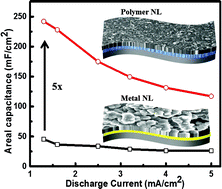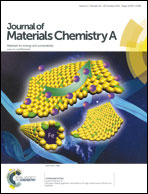A conducting polymer nucleation scheme for efficient solid-state supercapacitors on paper†
Abstract
In this study, a thin nucleation layer is used to tune the morphology of conducting polymer electrodes and to optimize the performance of paper based solid-state supercapacitors. It is found that using an acid-treated poly(3,4-ethylenedioxythiophene):polystyrenesulfonate (PEDOT:PSS) nucleation layer, prior to poly(3,4-ethylenedioxythiophene), PEDOT, electrochemical deposition, gives 5–6 times higher areal capacitance compared to a gold metal nucleation layer. Specifically, PEDOT supercapacitors with a high volumetric capacitance of 327 F cm−3, higher than any other PEDOT based supercapacitors reported in the literature, is achieved on the PEDOT:PSS nucleation layer; for the same devices, an areal capacitance of 242 mF cm−2 and an energy density of 14.5 mW h cm−3 at a power density of 350 mW cm−3 are obtained. Furthermore, these optimized PEDOT/PEDOT:PSS/paper electrodes are employed to fabricate solid-state supercapacitors using aqueous and ion gel electrolytes, with 32 and 11 mF cm−2 cell capacitance, respectively. The solid-state PEDOT device showed an energy density of 1.5 mW h cm−3 (normalised to the volume of the whole cell, including both the electrodes and the electrolyte), which is higher than the best reported ppy/paper (E = 1 mW h cm−3) and PAni/pencil/paper (E = 0.32 mW h cm−3) solid-state devices. The cycling performance showed that capacitance retention up to 80% is achieved after 10 000 cycles.


 Please wait while we load your content...
Please wait while we load your content...